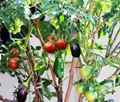
Mattu Gulla is more than just a variety of brinjal—it's a living symbol of heritage, spirituality, and the deep-rooted ecology of Karnataka’s Udupi district. Cultivated by a handful of farmers in the coastal village of Mattu and surrounding areas, this light green, round brinjal has won hearts for centuries with its distinct flavor and cultural reverence. Recognized with a Geographical Indication (GI) tag, Mattu Gulla stands as a potential game-changer for rural livelihoods—if only its story is told well and its market reach expanded.
Mattu Gulla: A Legacy Rooted in Faith and Folklore
The history of Mattu Gulla stretches back nearly 400 years, enriched by myth and spiritual belief. As legend has it, Sri Vadhiraja Tirtha Swamiji gifted the seeds of this unique brinjal to the people of Mattu village after a divine incident involving Lord Hayagriva. When the deity was unknowingly served poisoned prasada, his form turned bluish. To purify the offering and restore the Lord’s sanctity, the Swamiji instructed the cultivation of a new variety of brinjal—Mattu Gulla—and since then, it has been considered sacred. Even today, it holds a place of honor in temple rituals and household kitchens alike.
Exclusively Udupi: Where the Soil Meets the Sea
Grown only in a narrow coastal strip flanked by the Arabian Sea and the rivers Mattu and Papanashini, Mattu Gulla’s distinct character comes from its environment. The sandy loam soil, sea-kissed climate, and traditional use of organic fish manure all contribute to its exceptional taste. Cultivated primarily by small-scale farmers—many of whom also fish for a living—this brinjal is typically grown after the kharif paddy season, between October and June, on around 120 to 150 hectares of land.
A Delicacy With a Devoted Following
Unlike the common purple brinjals found across India, Mattu Gulla is pale green, rounded, and faintly striped with white. Its thin skin and low moisture content give it a melt-in-the-mouth quality after cooking. These unique characteristics make it a favorite in Udupi cuisine—especially in dishes like sambar, gojju, and palya. Its delicate, non-astringent taste turns everyday meals into culinary experiences.
From the Temple to the Table
Mattu Gulla’s spiritual significance is unmistakable. At the revered Sri Krishna Temple in Udupi, it is the only brinjal allowed in the temple kitchen. During the grand Paryaya festival, held once every two years on January 18th, the first harvest of Mattu Gulla is offered as Horakanike to the deity—a tradition that has remained unchanged for generations. This sacred link between faith, food, and farming makes Mattu Gulla more than a crop—it’s a cultural treasure.
GI Tag: A Milestone of Recognition and Protection
In 2011, Mattu Gulla was awarded a GI tag—a formal recognition of its unique geographic and cultural identity. This move was crucial, especially after concerns emerged over its unauthorized use in developing genetically modified Bt brinjal. While the GI tag safeguards its name and origin, the challenge remains in leveraging this recognition. Many farmers still face exploitation by middlemen and lack access to organized markets or promotional platforms.
Modern Challenges for a Traditional Crop
Despite its legacy and flavor, Mattu Gulla faces modern-day hurdles. Fish manure, once freely available, has become costly, pushing farmers toward alternative fertilizers. Pests and competition from high-yielding hybrid and Bt brinjals further threaten its viability. Of the 250 acres suitable for cultivation, only about 120 acres are currently used. Though average yields can reach up to 40 tons per hectare, profitability remains elusive.
However, the formation of the Mattu Gulla Growers’ Association offers hope. By raising awareness, improving buyer access, and protecting farmers' interests, the association has become a catalyst for change. But greater support in branding, digital marketing, and connecting with health-conscious urban consumers is urgently needed.
Health Benefits: More Than Just Tradition
Often underestimated nutritionally, brinjals—including Mattu Gulla—are rich in fiber, antioxidants, vitamins, and minerals. Studies have shown that eggplant juice may help reduce cholesterol levels, offering effects comparable to certain medications. This positions Mattu Gulla not just as a traditional favorite, but also as a potential functional food in modern diets.

Mattu Gulla is not just a vegetable—it’s a story of faith, sustainability, and identity. It mirrors the harmony between culture, religion, environment, and livelihood in Udupi. With the right blend of awareness, branding, and institutional support, this sacred crop can be revived and repositioned as a national, even global, icon of heritage agriculture.
Preserving Mattu Gulla is about more than taste—it's about safeguarding biodiversity, honoring tradition, and securing the future for generations of farmers and food lovers alike.
















